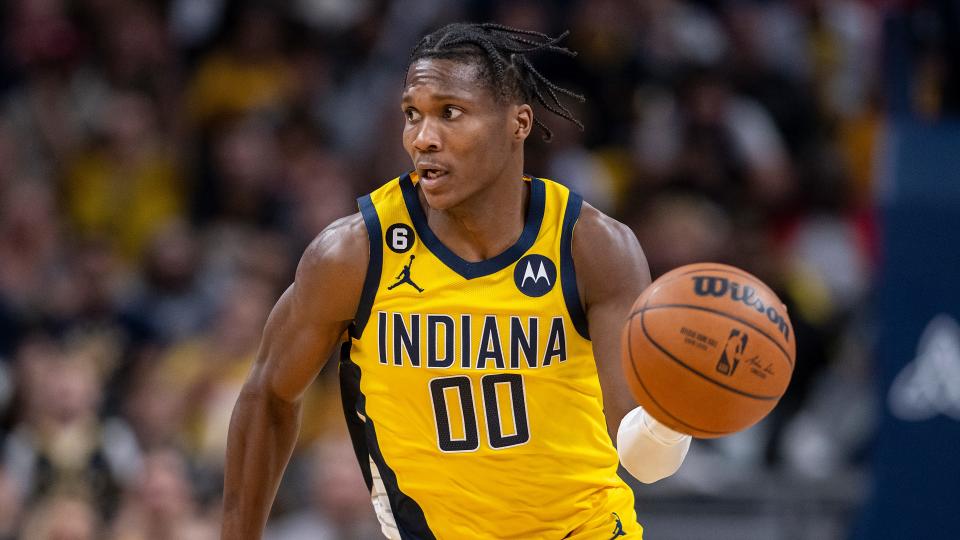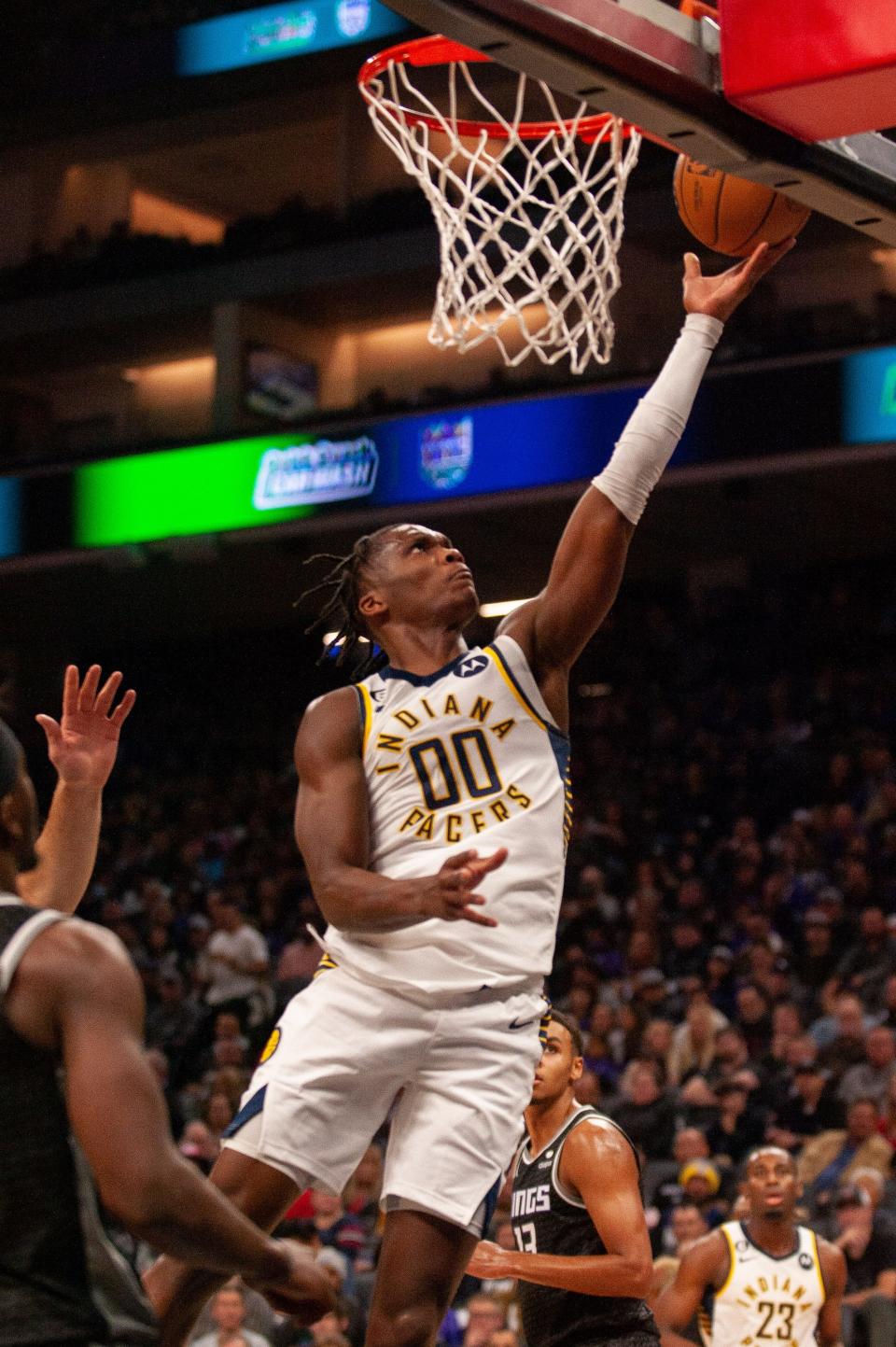Pacers rookie Bennedict Mathurin used NBA Academy to launch promising career
At 15, Indiana Pacers rookie Bennedict Mathurin had an adult decision to make.
Stay home in Montreal.
Or leave family and enter the NBA Academy Latin America in Mexico City.
“At first, I was like, ‘Nah, I’m not going there because I didn’t know what to expect,’ ” Mathurin told USA TODAY Sports. “But as I dug a little more and did my research, it might be one (of) the greatest opportunities of my life. Playing at the NBA Academy waslike (a) foot in the door to the NBA.”
Mathurin barged through that door.
The No. 6 pick in the 2022 draft, Mathurin is the second-leading rookie scorer at 19.1 points per game and the top 3-point shooter (48-of-115 for 41.7%) among rookies who have attempted at least 40 3s. He also flourishes in the open court and has the size and quickness at 6-5, 210 pounds to take hits and become a solid defender.
“The one thing that I’m so impressed with him is he’s just undaunted,” Pacers coach Rick Carlisle said after Mathurin scored 30 points against Denver on Nov. 11. “He continues to play his game. Doesn’t get down. Continues to have a strong belief in his abilities. He’s an attacker. He’s a rare young player that’s just unfazed.”
Headed for first-team All-Rookie, Mathurin, 20, is also a Rookie of the Year candidate and Sixth Man of the Year candidate, a rarity for a first-year player.
Mathurin is a significant reason why the 12-9 Pacers are one of the surprise teams in the East.
“The key is staying the same – staying as aggressive as I am and staying hungry,” he said. “Every day is an opportunity to step on the court. Every day is an opportunity to make a statement. I’ve kept the same mentality.”
The NBA Academy played a major role in Mathurin’s development. In 2016, the league opened its first academy as a year-round elite basketball development program for top high school age players. Now, there are academies in India, Senegal, Mexico and Australia. While working on basketball and life skills, players also attend school.
“The corporate side of this is that it’s a holistic, 360-degree development of a player and giving players the opportunity for a pathway to success, both academically and also as a basketball player,” NBA vice president and head of international basketball development Troy Justice said. “So, we really see them as student-athletes, and we look to develop them in every aspect of their lives.
“The non-corporate speak is that we’re making dreams come true.”
With about 18-24 players at each academy, there is a selection process with the NBA’s global scouting department looking for potential academy participants.
“Ben had been identified through our scouting system as a player that could have the potential to eventually be a really, really good player,” NBA senior manager and elite basketball coaching and player pathways lead Greg Collucci said. “He wasn’t overly locked into anything in terms of a pathway moving forward from where he was at that point in his life. We want to make sure that we approach players that make sense, that really want to take advantage of what we have in place and all the resources that we’re going to provide.”
The academy provides housing, multiple courts, weight room, educational facilities and dining areas and includes valuable instruction from the academy’s technical director, player development coaches, skill development coach, strength and conditioning coach, performance lifestyle practitioner, athletic trainer and academic coordinator.
It is a regimented program, starting with a 7 a.m. wakeup and 7:30 breakfast. From 7:45-9:15, players go to class and then practice from 9:30-11:15 followed by weightlifting and lunch. There is an afternoon break and players reassemble at 3 p.m. for 90-100 minutes of skill and player development and return to school from 5-8:30. That leaves time for dinner, a little relaxation and then sleep.
Walter Roese is the technical director at the Mexico City academy. He played college basketball, for the Brazil national team and professionally in Brazil. He also coached in college, for the Brazil national team and was a scout for the Utah Jazz.
“Our role here is to make sure, first, they understand the focus, and the importance of processes, time management and discipline – all those things that are very important for an elite athlete,” Roese said. “The idea is to help and maximize these prospects to become a better person, better player and better leader. We always talk about gratitude. The gratitude to be here, to have this opportunity to work out with excellent players and have all the tools that the NBA provides for us here.”
Roese remembers at first a shy Mathurin, which isn’t a surprise considering the circumstances. The son of a Haitian mom who grew up in Montreal, Mathurin adapted to his new environment.
“He had the leadership skill because one of the best attributes about Ben is how focused he was,” Roese said. “And he was sure. His confidence always was high. He always asked me to guard the best player on the other team. He was always going to compete. He always wanted to prove that he belongs there.”
Mathurin developed into a top-100 college prospect in 2020. After two years at Arizona where he was named Pac-12 player of the year as a sophomore in 2021-22, Mathurin had become a lottery pick.
The Pacers began changing directions last season, no longer content to finish seventh or eighth and a first-round playoff loss. They wanted more, which required a reset. They acquired guard Tyrese Haliburton and Buddy Hield from Sacramento for Domantas Sabonis before last season’s February trade deadline, and in the offseason, they traded Malcolm Brogdon to Boston for multiple players and a 2023 first-round pick.
In the 2022 draft, they sought a dynamic player with massive potential who could turn into a franchise cornerstone. They choose Mathurin.
In his first NBA game, he scored 19 points followed by 26 and 27 points, and in his seventh game, he scored 32. With Haliburton (19.9 points and 11.3 assists per game) and Mathurin, the Pacers soon will have one of the best backcourts in the league, if they’re not there now. And one of the league’s weirdest numerical backcourts. Haliburton wears 0 and Mathurin 00.
“Every once in a while, there is a young player that comes out of college whose game is much more suited to the NBA than college, and I think Ben might be one of those guys,” Carlisle said. “He had great coaching in college and was Player of the Year in the Pac-12. … But it is unique for a guy at this stage to have that feel.”
Mathurin grew up in a competitive household. His older sister, Jennifer, played college basketball at North Carolina State, and Mathurin and his brother, Dominique Jeune, shared the same dream: play in the NBA. But when Jeune was 15 and Mathurin 12, Jeune was riding his bike home from school and was killed when a car hit him.
Mathurin has his brother’s name, birthdate and date of the accident tattooed on his inner arm.
“He’s my inspiration,” Mathurin said. “He wanted to play in the NBA. It was a mission for me and him as well.”

